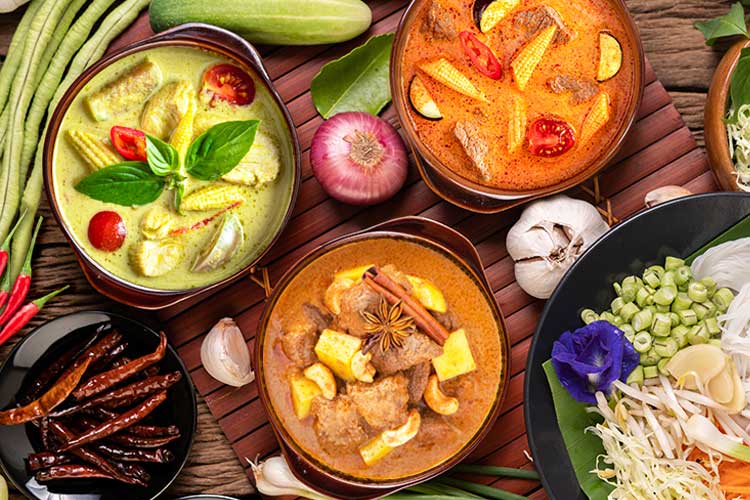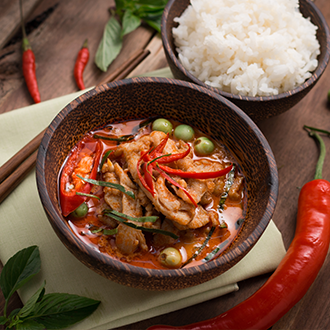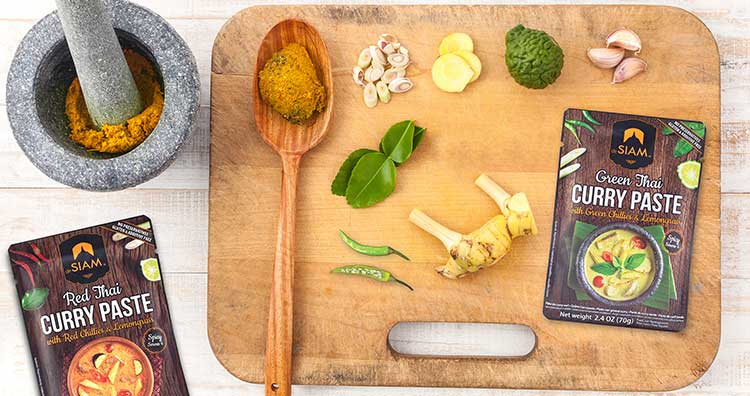My shopping cart
Your cart is currently empty.
Continue Shopping
Thai curry paste, called “Prik Gaeng” in Thai, is a staple ingredient for Thai cuisine, especially curry dishes. Thai curry paste is different from Indian curry paste in terms of ingredients and flavor profile, so you cannot substitute one for another. Thai curry paste is made from a mixture of fresh herbs, spices, and aromatics.
There is an extensive list of curry pastes in Thailand, but some common ingredients are shrimp paste, shallots, garlic, lemongrass, galangal roots, coriander roots and chilies.
However, the type of chili used depends on the curry, and whether it is dried or fresh, red or green.
To make the paste in traditional way, all ingredients are slowly mixed and pounded into a paste in a granite mortar and pestle. This simple method takes time to get a fine paste going but can bring out natural aromatic and flavorful taste from all herbs and spices.
However, now a food processor or blender is more convenient choice, and the ready-made Thai curry paste is surely a life and time saving product, especially for beginners.
In Thailand, there are hundreds of curry paste types, including those from specific regions around the country. But there are a few pastes that are widely used and we will give you a guideline of what goes into them and how they can be used for cooking.

Red curry paste, in Thai called ‘Prik Geang Phed’, consists of dried red chilies, garlic, salt, lemongrass, galangal, shrimp paste, makrut lime leaves, coriander root, coriander seeds, cumin seeds, and peppercorns.
The red coloring derived from dried red chilies, mostly uses red chili spur peppers but other dried red chilies can be added to the recipe. Despite its bright red color, the paste is less spicy than the Green curry paste because it uses dried chilies whilst the Green paste uses fresh, but spicier chilis.
Red curry paste is a versatile and flavorful base for a variety of Thai dishes.
Besides making the classic coconut-based red curry, it is used for stir-fry with tofu or meats like pork or chicken. Mix with ground fish or seafood to make Tod Man Pla (Thai Fish Cake) or Hor Mok Pla (Thai Fish Custard). You can also make the curry without coconut milk, and it is called ‘Geang Pa’ (Jungle Curry) in Thai.

Green curry paste is called ‘Prik Gaeng Khiao Wan’ literally meaning ‘sweet green curry’. Despite its sweet name and look, Green curry paste tends to be more pungent and the spiciest of all our curry listed here.
It uses similar ingredients to the Red curry paste, but the major difference is the use of fresh green chilis. Traditionally, Thai people like to add coriander leaves and chili leaves to add greener color to the paste. This also give a different scent and flavor profile to green curry as well.
Green paste is traditionally used to make coconut-based curry with any kind of meats from beef, chicken, pork, to vegetarian choices like tofu or broccoli. Stir-fried dish with meat or fried rice with green curry are also popular choices.

Yellow curry paste is known locally as ‘Prik Gaeng Garee’ and consists of shallots, salt, lemongrass, red chili, garlic, galangal roots, coriander roots, kaffir lime peel, lime juice, white pepper.
A few extra ingredients like Ginger roots and yellow curry powder give the yellow paste its distinctive aroma and color. It generally contains less chili than other curries, so it is milder in spiciness and good to serve for a kid’s meal. Thai Yellow Curry Chicken is a common dish.
The paste is also used to make coconut curry broth for the Northern style noodle Chicken Khao Soi. It can be used as a rub or marinade for Satay skewers or combined with coconut cream and used in fish stews.

Panang curry paste is called ‘Prik Gaeng Panang’ in Thai. Its ingredients are similar to Red curry paste, but ground roasted peanuts are added to the recipe. The peanuts also give Panang its nutty flavor and aroma and its uniquely rich consistency.
Panang curry dish is usually thicker and richer than the classic Red Curry dish. But if you don’t have Panang paste at home, you can add ground roasted peanuts to Red curry paste, and use coconut cream instead of coconut milk, to make it creamier.
An alternative idea to using Panang paste is to mix it with ground meat and turn the mixture into a delicious burger!

Massaman curry paste, or Prik Gaeng Massaman, uses similar ingredients like Yellow curry paste, but has more aromatics, such as, cardamom seeds, cloves, cumin seeds and cinnamon.
They are usually roasted before being grounded and mixed with other ingredients which give Massaman an extra fragrance. Massaman Curry is usually made from meat like pork, beef, chicken or lamp, with potatoes and whole peanuts, and cooked in coconut milk. Seasoned with tamarind sauce, fish sauce and palm sugar.
Traditionally, Massaman curry is served with a sour side dish like Ajad (cucumber slices and onions in vinegar), spicy salad, or pickled vegetables.

The method of cooking most curries is similar.
First, heat a spoonful of vegetable oil in a saucepan (or pot) on high heat. Add the paste and stir-fry for a few minutes before adding a few tablespoons of coconut cream, make it like a thick sauce.
Add meat or sturdy vegetables like potatoes or carrots to the sauce, then add the coconut milk. Put the rest of the ingredients into the saucepan, season with fish sauce and a bit of sugar.
Simmer the contents of the saucepan until cooked through. If you use light/delicate meats like fish, shrimp or other seafood, you can add the meat in the last step instead of cooking it with thick sauce in the beginning.
Besides making curry dishes, as we mention above, curry paste can be used in many other ways.
Check out our article “5 ways how to use Thai curry paste for cooking” for more cooking ideas.

For ready-made curry paste, keep the package in a cool dry place, away from direct sunlight or heat.
Once the package is opened, keep it in the zip-lock or tight sealed container and keep it in the fridge and consume within 1 week. If you don’t plan to use it within a week, store in the freezer, it can be kept for up to one month.
Homemade curry paste can be stored the same way in the fridge, but should be used within 2-3 days or kept in freezer for up to 2 weeks for the best quality and aroma of the paste.